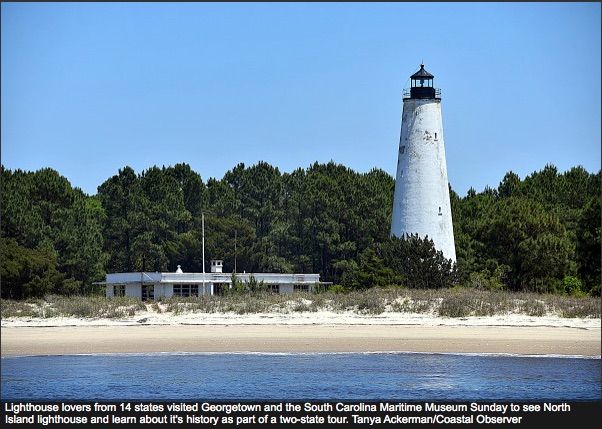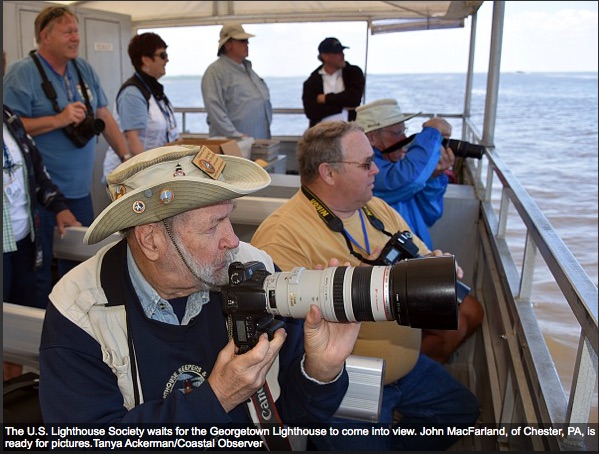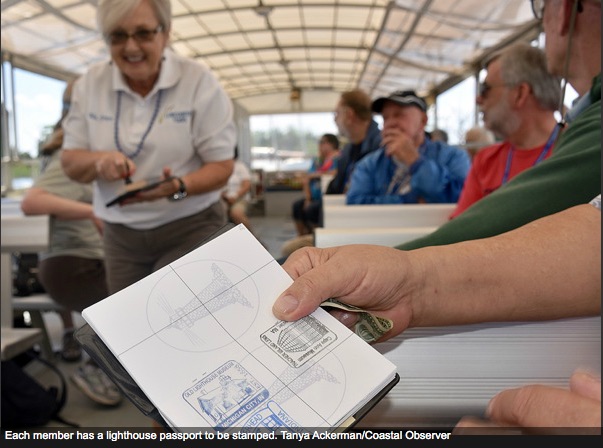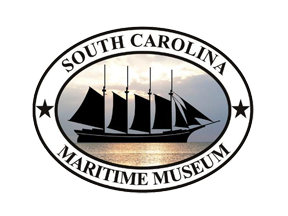Lighthouse lovers from 14 states visited Georgetown
Drawn by the light
By Jason Lesley
Coastal Observer
Lighthouse lovers from 14 states visited Georgetown and the South Carolina Maritime Museum Sunday [May 3, 2015] to see the North Island lighthouse and learn about its history as part of a two-state tour.
Accompanied by Mac McAlister of the maritime museum, 37 members of the United States Lighthouse Society cruised down Winyah Bay with Capt. Rod’s tours. Though they were disappointed at not being allowed to walk on the grounds or climb the stairs of the 87-foot tower because of recent vandalism, members of the group appreciated the history of North Island and an opportunity to see the fifth order Fresnel lens that provided light at the entrance to Winyah Bay for over 100 years.

Skip Sherwood of Kingston, Wash., leader of the group, said the lighthouse society is dedicated to the preservation of lighthouses and their history. It’s based near the Point-No Point Lighthouse on Puget Sound in Washington. “We raise money by doing tours all over the world,” Sherwood said. “One group just got back from the Netherlands.” The tour that came to Georgetown by charter bus included the Cape Romain lighthouse and others at Sullivans, Morris and Hunting islands near Charleston, the remains of a lighthouse at Parris Island and concluded at Little Cumberland Island, Ga. Thirteen of the participants were from California. “It’s not like we live near each other,” said Sherwood, a retired college professor. “These people like to climb lighthouses.”

Georgetown’s lighthouse is the oldest in South Carolina and was the last lighthouse in the state to have its operators removed. In 1986, the light was automated and its six-person crew reassigned. It was the second structure at North Island. The first, a 72-foot cypress tower, was finished in 1801 along with a two-story keeper’s dwelling and a tank for holding the whale oil that fueled the lighthouse’s lamp. The wooden tower’s life was cut short by a violent storm in 1806.

Congress appropriated $40,000 to rebuild the lighthouse in such a manner “to secure its future safety.” This time the tower was constructed of brick. A marble plaque positioned above the door records the names of those who built the tower and lists 1811 as the year it was completed. Thomas Walker and James Evans, contractors from Charleston, were responsible for constructing the lighthouse, and they reportedly used slave labor. The staircase that spirals upward inside the stout brick tower is made of stone. In 1850, 11 lamps and a corresponding number of 14-inch reflectors were being used to produce a fixed white light. A Fresnel lens replaced the antiquated lamp and reflector apparatus in 1854, while retaining the same light characteristic.

After the Civil War broke out, the Confederates used Georgetown lighthouse as a lookout station, until Union forces captured it in May of 1862. The lighthouse was heavily damaged during the war, and as part of the post-war repair work, the tower was heightened to 87 feet. This work was carried out in 1867 and included the installation of a new lantern room and a new lens.
A priority for members of the group was to get their books stamped with the image of the North Island lighthouse. They each paid a dollar for the privilege. Sherwood explained that the lighthouse society sold 10,000 passport books containing 60 squares for stamps to direct $600,000 to lighthouse preservation. “It’s a dollar at a time,” he said, “but it adds up.”

McAlister said the group enjoyed their cruise, peppered with facts and observations by Capt. Rod. The chance to see the Fresnel lens was a bonus for them. The lens was moved to the S.C. Maritime Museum last year with the assistance of the Coast Guard.

Lighthouse lore: Tommy Graham will talk about the lighthouses of Cape Romain at the S.C. Maritime Museum. The program is May 13 at noon. The cost is $15 and includes a buffet lunch from Alfresco Bistro. Go to scmaritimemuseum.org to register.
